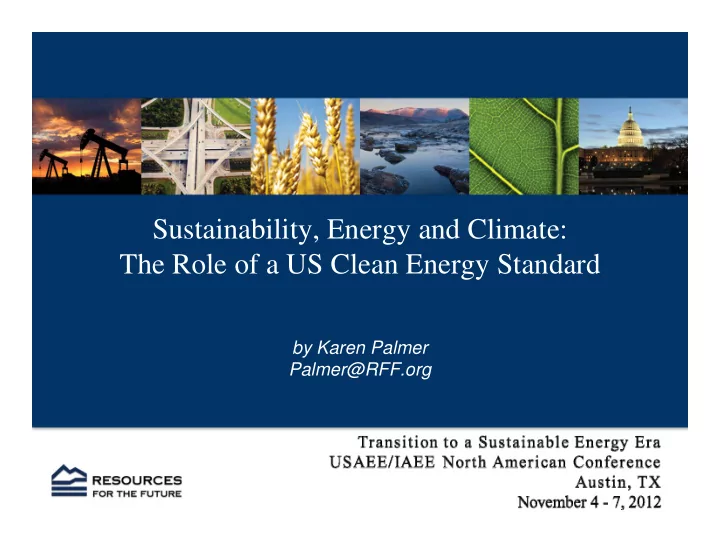

Sustainability, Energy and Climate: The Role of a US Clean Energy Standard by Karen Palmer Palmer@RFF.org
Policy Context for a Clean Energy Standard Climate has been an important factor in energy policy debates in Washington for past couple decades. Several proposals for CO 2 cap-and-trade in the early 2000s, then Waxman-Markey passed the House in 2009 but failed to get traction in the Senate. Recent focus has shifted to EPA regulations and policies to encourage energy efficiency and clean technologies . State and regional cap-and-trade programs (RGGI, CA) are part of the mix. For electricity, clean energy standards have had some support in Congress, as they include a range of generation sources. The wild card that is being discussed in more of a fiscal context than an environmental sustainability context is a federal carbon tax . 2
What is a Clean Energy Standard? • Minimum percentage of electricity from clean sources. – Minimum grows over time – Clean Energy Credits used for compliance – Credits are tradable and could be bankable • Clean Energy Standard similar to renewable portfolio standard in concept but includes more technologies: – Nuclear and Hydro – Fossil with CCS (partial credit) – Natural gas (less partial credit) • Earlier proposals: – Clean Energy Standard Act of 2010 (Graham D-SC) – Obama Administration(2011 State of the Union) 3
The Clean Energy Standard Act of 2012 (S 2146) • Obligation –Applies to all non exempt retail utilities –24% in 2015; 84% in 2035 • Qualified Technologies and Credits –renewable, natural gas, hydro, nuclear ( post 1991 ) –Crediting rate is 1 – ((CO 2 /MWh)/0.82) –No negative credits • Credits fully tradable and bankable • Alternate Compliance Payment (ACP) –$30 per MWh in 2015 rising at 5% real per year –Caps clean energy credit price • Policy Exemptions –Small utilities (SUE) (< 2 M MWh in 2015, < 1 M MWh 2025 on ) –Electricity sales from older hydro and nuclear units 4
Questions about CES Policy Performance • How does the CES affect emissions, electricity prices and composition of supply? • How does the CES compare to a carbon tax? We use RFF’s Haiku electricity market model to analyze these policies. 5
National Electricity Sector CO 2 Emissions (billion tons) • CES − cumulative reduction: 21% of Baseline − 2035 reduction: 27% of U.S. pledge to U.N. process, from only electricity sector • CES w/o ACP − cumulative reduction: 33% of BL − 2035 reduction: 41% of U.N. • CES w/o ACP or SUE − cumulative reduction: 46% of BL − 2035 reduction: 49% of U.N. 6
National Average Retail Electricity Prices ($/MWh) Price effect depends on policy design • CES − little effect for first decade − 17% increase in 2035 from BL • Carbon Tax − raises price by 9% in first year • CES w/o ACP or SUE − 41% increase in 2035 from BL − 20% increase in 2035 from CES • CES w/o Nuke/Hydro Exclude − 13% increase in 2035 from BL 7
Regional Electricity Prices Effects of CES in 2020 ($/MWh) No effect on national average price masks regional differences. 8
Regional Electricity Prices Effects of CES in 2035 ($/MWh) CES causes prices to increase everywhere in 2035. Price impact is mix of generation mix effect and SUE effect. 9
CES versus Carbon Tax: National Generation Mix (TWh) Coal is hit harder by a CES than by a comparable carbon tax. Clean technologies do better with CES than with carbon tax. 2020 2035 5,000 Other 4,500 4,000 Wind 3,500 New Nuclear 3,000 2,500 Nat Gas 2,000 Steam Coal 1,500 Hydro 1,000 500 Existing Nuclear 0 Baseline CES Carbon Tax Baseline CES Carbon Tax 10
Conclusions The S2146 CES substantially reduces CO 2 emissions and increases share of electricity produced by renewables and natural gas. The CES will increase electricity prices in the long-run, but initial price impacts will be small and even negative in some parts of the country. The effects of a CES policy depend on its features such as the ACP and SUE. A carbon tax with similar environmental effectiveness will yield bigger price effects, more energy conservation and less dramatic technology shift away from coal to other sources. Will either policy be used in the US to pave the way to a more sustainable future? Stay tuned… 11
Thank you. Thank You!
Recommend
More recommend